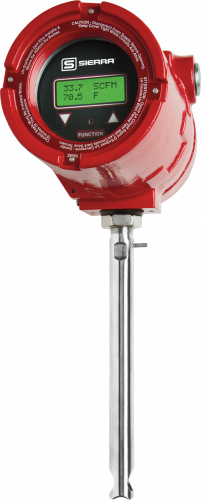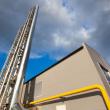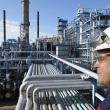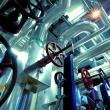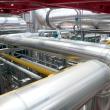Insertion Gas Mass Flow Meter
SteelMassTM 640S
- Insertion, totalizing air/gas mass flow meter
- Eliminate drift with patented DrySense™ sensor
- Increase flexibility with low pressure drop, high turndown
- Validate in the field for easy in-situ calibration
- Backed by lifetime sensor warranty
Overview
Named North America's #1 selling thermal mass flow meter (2009 Flow Research, Boston MA), Sierra’s SteelMass Model 640S delivers precise measurements for heavy-duty industrial gas mass and air flow meter measurement applications. This insertion thermal mass air/gas flow meter offers precision SCFM (standard cubic feet per minute), SFPM (surface feet per minute) and SMPS (standard meters per second) measurement of gas mass flow rate in industrial environments.
The SteelMass 640S insertion flow meter provides more accurate monitoring of peak, low flow and total air/gas mass flow rates, a critical part of many industrial process control systems. If you need a portable analog or digital air flow meter that easily inserts into industrial ducts and pipes up to 72 inches (2 m), choose SteelMass® 640S.
The 640S compressed air flow meter is GHG certified and ideal for:
- Air volume flow metering
- Compressed air flow
- Aeration basin air flow
- Combustion air flow
- Natural gas fuel flow
- Custody transfer
- Stack gas emissions flow monitoring
Operating Principle: Thermal dispersion technology provides direct mass flow measurement featuring: no pressure or temperature compensation needed; no moving parts; low pressure drop; and high turndown. Watch the video to learn about Thermal Principle of Operation.
FAQs
Q: How do I calibrate my 640S air flow meter?
A: Customers often ask if they need to have their flow meter instrumentation calibrated annually. Along with calibration-related questions, traceability is another area that garners its fair share of inquiries. For industrial thermal flow meters, the answer is no—annual calibration isn’t necessary. However, industry standards like ISO 9001 and quality assurance procedures may still necessitate sending in your meter for periodic recalibration, typically once a year. For example, natural gas is another example of an industry with stringent guidelines, in this case for bulk gas custody transfer applications. In-situ calibration validation, however, is one of the great benefits of thermal mass flow technology. Learn more about the best methods of in-situ calibration validation so you can make informed decisions.
Q: What is a thermal mass flow meter?
A: A thermal mass flow meter is a device that measures the gas flow rate running through a pipe. Thermal meters work by measuring the total mass flow rate of air/gas flowing through a pipe or duct. In a thermal flow meter’s simplest working configuration, gas flows past a heated velocity sensor and a temperature sensor. A constant temperature differential of 50 degrees Celsius between the actual gas temperature and the heated velocity sensor is maintained through instrument electronics.
A cooling effect occurs as heat is transferred to the flowing gas molecules and carried away when the molecules of the gas flow past the heated velocity sensor. The actual watts required to maintain a constant 50 degree Celsius temperature differential between the two sensors is directly proportional to the mass flow rate of the gas. The amount of heat loss depends on the thermal properties of the gas and the flow rate of the gas.
Product Benefits
|
|
Specifications
|
|
 Go to Autotest Division >
Go to Autotest Division >